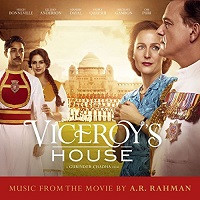- Composed by A.R. Rahman
- Filmtrax / 2017 / 44m
Viceroy’s House is the Upstairs, Downstairs of the Indian partition. Set in the Delhi palace of Lord Mountbatten in 1947, the film explores the relationships unfolding in the servants’ quarters. Starring Hugh Bonneville and Gillian Anderson as the English masters and Manish Dayal and Huma Qureshi as the Indian servants, the film boasts a very strong supporting cast including Michael Gambon and Om Puri, and has received reasonable reviews despite criticism that it rather trivialises the extremely serious events unfolding at the time.
The score is by the great A.R. Rahman, whose occasional forays into western productions are almost always worthy of some note (even when the films themselves are awful, as was the case with the execrable Couples Retreat, for which he somehow concocted a genuinely lovely score). While it may have been a bit of a busman’s holiday for him to move away from Indian cinema to work on this, a British film set in India, it played into his hands, allowing him to write a heavily westernised view of Indian music (think Marigold Hotel) which is really very impressive.
While he is known as the Mozart of Madras, in film music terms Rahman is somewhere a lot closer to Hans Zimmer, writing often-striking music, favouring grand dramatic gestures, incorporating various world music ideas and making them palatable to more middle-of-the-road tastes. Where this score goes away is its surprisingly traditional symphonic nature (there are none of the Remote Control stylings from his recent Muhammad score, for instance).
The album opens with a beautiful orchestral treatment of the main theme – when heard first for solo viola with orchestral accompaniment, it’s very Morricone-like, then after a more light-hearted passage it re-emerges, this time on ethnic instrumentation and it’s really very lovely indeed. A second theme is introduced in the next cue, “Displacement”, this one a lot sadder and emotional – as its name suggests, it’s Rahman’s musical treatment of the horrible consequence of the Indian partition at the time of independence. Following this is a dramatic piece built from the main theme, “Swearing In”, which has quite an English feeling to it, building to a gorgeous summery conclusion.
“Jinnah Meets Mountbatten” sees the strings really take off – there’s a mid-1990s James Horner-style dramatic swell to its earlier moments. Next comes another major theme, this time the love theme, in “Limerence” – it’s quite a soft, gentle piece with a sense of floating in the breeze – it’s really very charming. The brief “Gandhi” reprises the “Displacement” theme, this time reduced to chamber proportions. After the pleasant “Pamela and Alia Bond” comes the first real tension in the score, “Dickie is the Man”, with subtle electronics joining horns and rather choppy strings; the second half of the piece sees rumbling percussion acting as a harbinger of bad news. The love theme is back in the wistful, wispy “Two Broken Hearts”, where Rahman plays it almost in a dialogue with the main theme – it’s very accomplished writing and really rather moving.
The score gains a real dramatic thrust in the wonderful “Ahimsa”, which sees the theme from “Displacement” heard as a kind of lament for solo female voice, with tense percussion at first surrounding it, then an extremely sad feeling emerges as the orchestral forces grow; the same theme is heard, along with the main theme, in the subsequent “The Partition”, where a male vocal joins the female – the contrasts a fascinating way of musically representing the event.
The tension mounts through “Classified”, with dramatic percussive hits appearing like lightning bolts in the murky clouds around them, before Rahman truly lets rip in the concluding four pieces. “The Birth of Two Nations” is simply outstanding, hope rising from the ashes of the previous cue, a choir joining the full forces of the orchestra and ethnic soloists – it’s musical grandstanding, ravishing and richly rewarding. The explosion of melody midway through the cue is like a musical firework going off, though the piece does end with an air of caution, the “Displacement” theme given a brief airing – and it’s that same feeling that dominates the subsequent “Exodus”, a powerful piece full of sadness, the vocals proving to be very moving once again. The broad dramatic strokes with which Rahman paints turn into quite a striking canvas as the main theme emerges midway through the cue. Then comes the payoff in the gorgeous “Jeet Finds Alia”, with the emotional release in the impassioned performance of the love theme feeling well and truly deserved.
There’s still time for a rousing finale, “The Cost of Freedom”: and in fact the composer has saved the best for last. The main and love themes are given very strong performances, and the hints of Vaughan Williams that appear are really nicely done. This is quite old-fashioned film music, in the best sense of the phrase: it’s steadfastly melodic, even in the darker moments, it goes through a rich emotional journey, the thematic content is strong. I’m usually impressed by A.R. Rahman’s music; I’ve rarely been more impressed by it than Viceroy’s House, a beautifully-woven tapestry of a film score.
Rating: *****
facebook.com/moviewave | twitter.com/MovieWaveDotNet | amazon.com













Excellent review of a charming score. 🙂